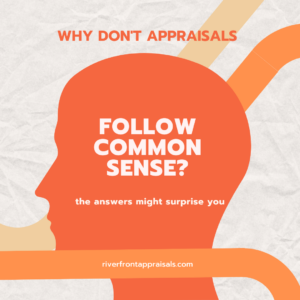
Property Taxes Just Went Up? We’ve Got You Covered!
It’s reassessment season for most folks in our area. Homeowners

Right now on our Appraisal Blog, we’re all about helping Loan Officers. This post is part five of a 12-part series we’re calling The Loan Officer’s Guide to Appraisals. So far in our series, we’ve looked at final inspections, lending on unique homes, communication with the appraiser, and reconsiderations of value. So if this is your first time reading our blog, take a few minutes and read through our previous posts to get caught up.
In this blog post, we discuss the topic of bracketing. Most lenders want to see it done, not everyone understands it, and appraisers don’t like it when they feel pressured to do it! So what exactly is bracketing?
[bctt tweet=”So far in our series, we’ve looked at final inspections, lending on unique homes, communication with the appraiser, and reconsiderations of value. So if this is your first time reading our blog, take a few minutes and read through our previous posts to get caught up.” username=”RiverfrontApp”]
Definition of Bracketing
Simply put, bracketing is choosing comparables that are both superior to and inferior to the subject, which ultimately sets the high and low range of value for the subject. We’ll return to this later.
Conceptually, bracketing provides a balanced approach to valuation, and helps prove the appraiser’s lack of bias. If I include sales which are both inferior and superior, it would be hard for anyone to accuse me of undervaluing, overvaluing, or appraising with bias. However, if the subject I’m appraising is under contract for $325,000 and all my comps sold over $350,000…well, that’s a tougher case to prove.
One of the ways bracketing helps appraisers and loan officers understand a home’s value is with adjustments. Bracketing can be a big help to appraisers when extracting and applying adjustments – especially when sales are limited. If sales are few, then some techniques like group pairs or regression analysis might not be available to the appraiser. This is where more qualitative analyses like sensitivity analysis comes in handy.
Example:
If I’m appraising a home at the lake and the home is situated across the road from the water, with a nice but slightly obstructed water view, I need to be able to determine if a view adjustment is necessary and if so – how much. I have three sales in my appraisal report.
Comp 1: directly on the water with an unobstructed view sold for $375,000.
Comp 2: across the street with slightly obstructed water views similar to the subject sold for $325,000
Comp 3: down the road ¼ mile from the lake with only residential and wooded views sold for $300,000
In this case, since we have inferior and superior views, it’s easier for an appraiser to develop an adjustment for view, and for that adjustment to be supported. If all of the sales were directly on the water like Comp 1 above, it would be much more difficult to support an adjustment.
If all three of my sales were identical except for view, the adjustment would be easy to extract. This is an example of matched pairs. I would simply adjust Comparable #1 down $50,000; Comp #2 would receive no adjustment, while Comp #3 would be adjusted up $25,000. But if the homes were not identical in every other way, by bracketing the view, these sales still provide a range for the appraiser to make an adjustment. My adjustment range will likely be between $25,000 – $50,000. It would be up to the appraiser to choose the appropriate amount to adjust. Again, without bracketing, it would be much more difficult for the appraiser to extract and support an adjustment.
Can an appraiser use a sale from another neighborhood just to bracket?
Remember that comparable sales should all pass the test of substitution. The appraiser must analyze closed and pending sales, as well as listings of properties and determine which are acceptable substitutes. So no matter what, the goal of bracketing should never trump proper comparable sale selection. Usually when a sale is included in order to bracket only one feature, it’s included after the most comparable sales are used – those that are true substitutes. So if I have to, sure – I’ll use a sale from a few miles down the road just so I can include a sale of a one bedroom home like the one I’m appraising but I’ll usually add this sale to the Comps 4-6 section, and I’ll explain what I did, why I did it, and what affect this has on value and marketability (if any).
Is bracketing even a requirement?
While USPAP doesn’t have anything to say about bracketing, Fannie Mae does chime in a time or two. One of which has to do with the final estimate of value and the range of adjusted comps. Fannie Mae states:
It should be noted that the indicated value in the Sales Comparison Approach must be within the range of the adjusted sales price of the comparables that are reported in the appraisal report form.
So let’s say the home being appraised is under contract for $279,000. Comp #1 adjusts to $269,000; Comp #2 adjusts to $272,000 and Comp #3 adjusts to $283,000. If the appraiser develops their opinion of value to be $285,000, then that issue will need to be resolved before moving forward with the loan.
Think you’ve got a grasp on bracketing? Still confused? Let’s expand our definition a little, and give another example.
As we’ve already discussed, bracketing occurs when an appraiser applies qualitative analysis (greater than / less than, or superior to / inferior to) to a group of comparable sales. In this process, some comparables should be superior to the subject, and some should be inferior. The sales could be superior/inferior in any number of ways, such as square footage, quality, condition, view, location, and on and on.
For those features which are superior to the subject, the appraiser will make a downward adjustment to the comparable sale price; and for those features which are inferior, a positive adjustment to the sale is made. After the appraiser is finished making adjustments to these comparables, what’s left is a range of value – or bracket – in which the value opinion should fall.
Example #2:
Let’s consider another example, this time using square footage. Assume the subject property has 2,500 square feet of gross living area (GLA). It’s a hot market and inventory is low. The subject is in a neighborhood with very few sales in the past year, but there have been a couple. Just not any with 2,500 square feet. So to bracket the square footage of the subject, the appraiser would need to find a sale with say, 2,300 square feet, and another with 2,800 square feet, for example. A positive adjustment would be made to the smaller house, while a negative adjustment would be made to the larger house.
Another reason for bracketing is to demonstrate marketability. In the example above, the lender wants to make sure a 2,500 square foot home is marketable, and one of the best ways to do this is to include sale of smaller as well as larger properties. If all the sales were smaller, is the subject an over improvement? If all the sales are larger, is the home under improved for the market? These are questions an underwriter will be asking.
What if I can’t bracket?
Although bracketing isn’t a requirement, most lenders do want to see it done. Some lenders and AMCs even want to see every element on the sales grid bracketed. That means no ‘across the board’ adjustments. But what if the appraiser simply cannot bracket every feature? In this case, an explanation should be included. The appraiser should explain the lengths they went to in order to bracket – how far back in time and distance – and what affect (if any) the lack of bracketing has on value, marketability, and the reliability of the appraiser’s conclusions.
Conclusion
While not a requirement for every appraisal, bracketing definitely does have its uses and benefits to you, the loan officer. The next time you review an appraisal, look at the grid of comparable sales, and see if you can tell how the appraiser bracketed. For the majority of the subject’s features, you should see a good mixture of plusses and minuses to the comparable sales, indicating the sales used were both inferior to and superior to the subject. If you see this, and the adjustments are well-supported, then you likely have a very well-written appraisal report and you can proceed with confidence with your loan.
Committed to helping you understand your home’s market value,
Ryan Bays, SRA, AI-RRS

It’s reassessment season for most folks in our area. Homeowners

I feel like we all need a laugh. How about

So this may be a slight break from the norm,
Riverfront Appraisals has been providing comprehensive valuations of residential properties to Western Kentucky and Southwestern Indiana since 2008.